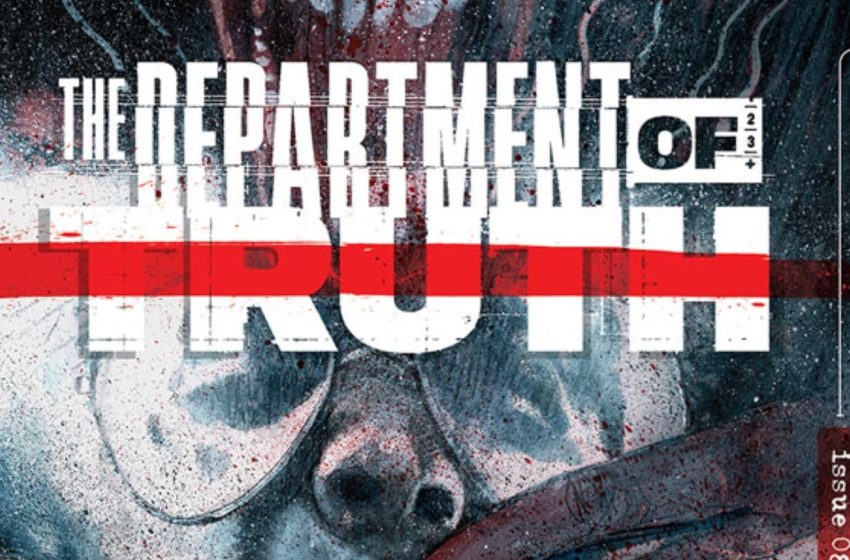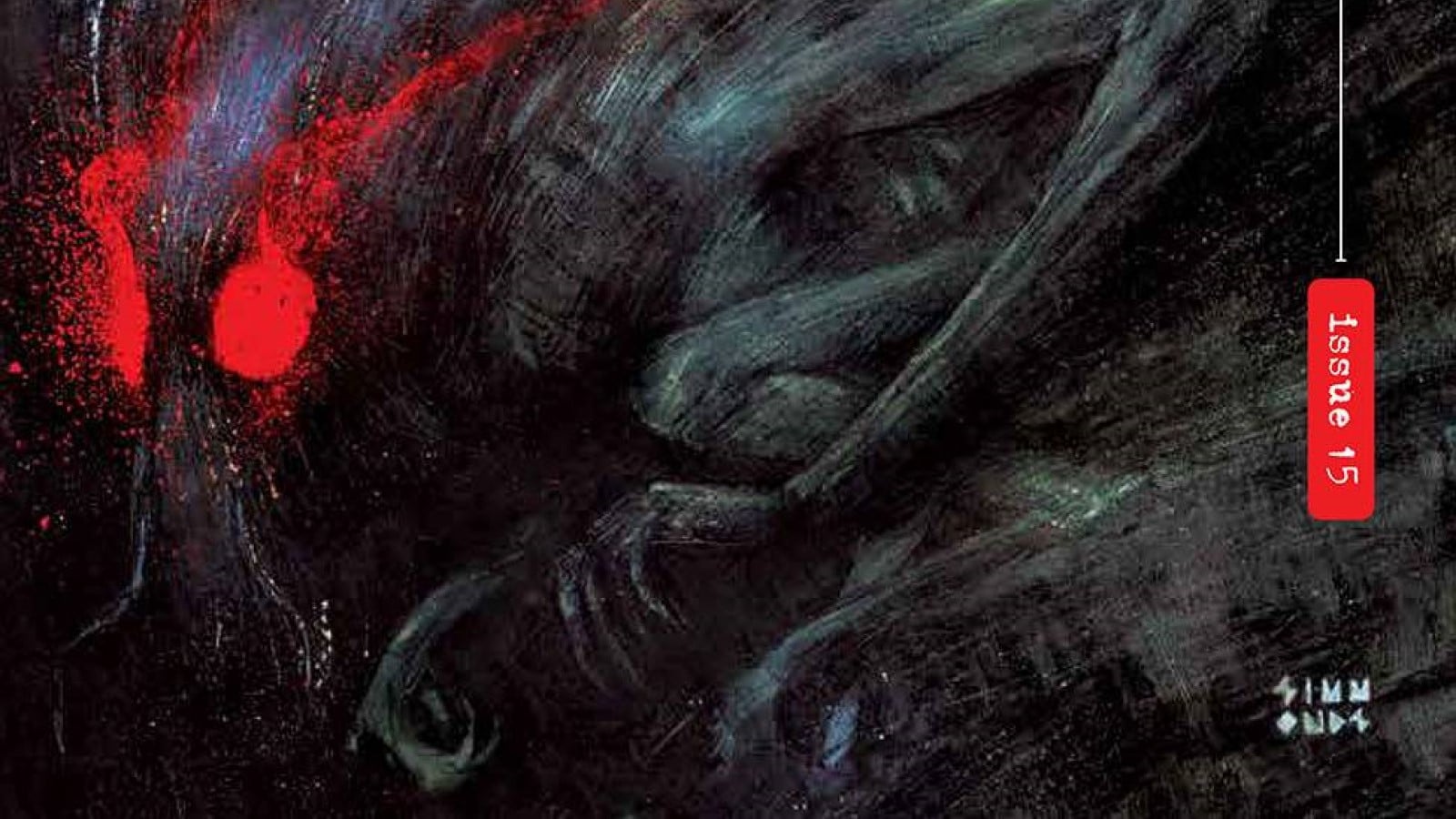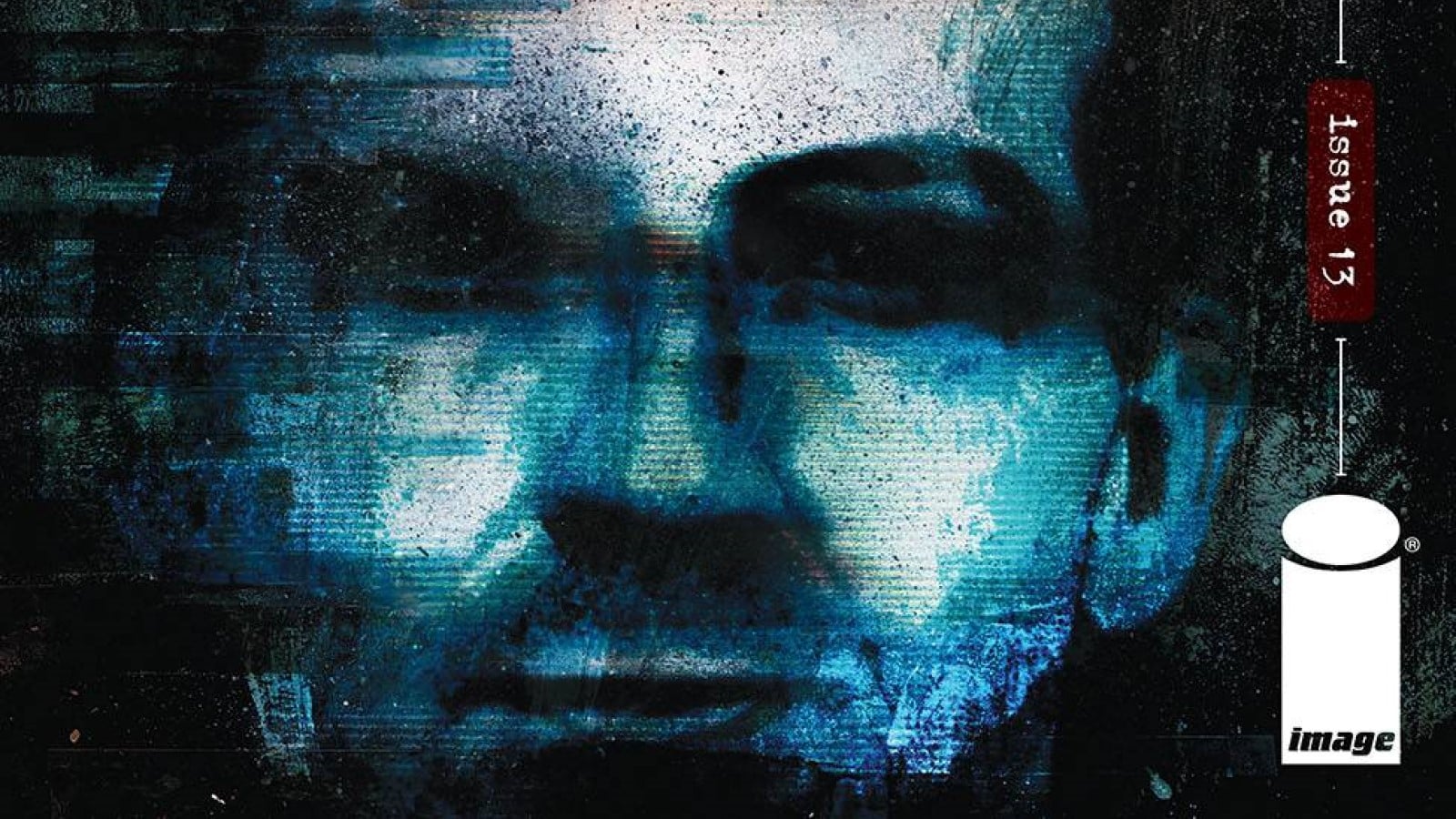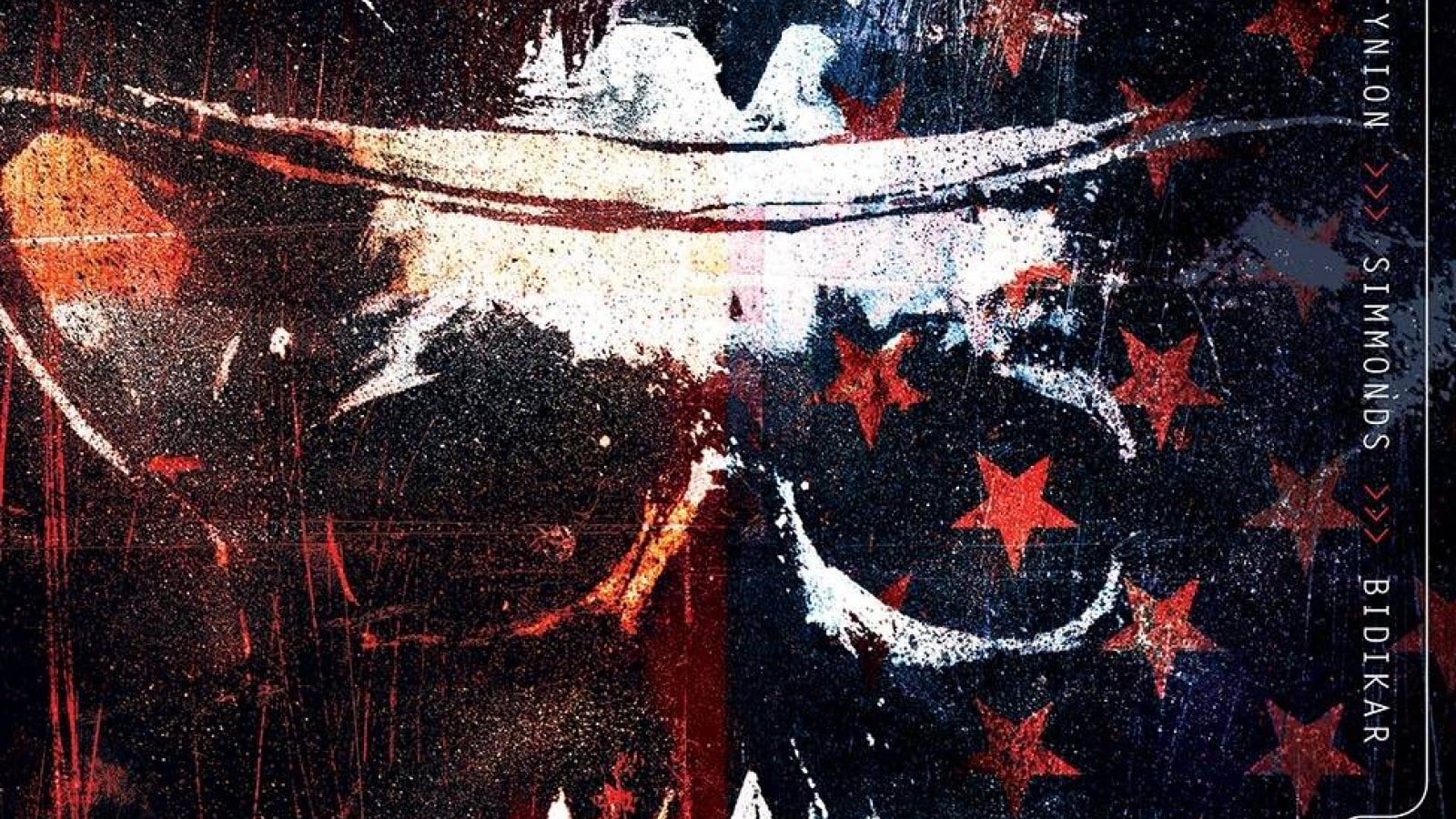Wanna get away? Maybe to see the Rockies and visit the headquarters of the New World Order? Let Department of Truth #8 by writer James Tynion IV, artist Martin Simmonds, letterer Aditya Bidikar, designer Dylan Todd and editor Steve Foxe be your guide.
Will Nevin: Forrest, my friend, vacations are nice. Go new places. See different things. Get away for a bit. But it’s always nice to come home, isn’t it?
Forrest Hollingsworth: Will, I took a look around and this house seems pretty fucked up and it also looks a lot like an airport. Maybe it’s all a matter of perspective.
WN: You know, if I have to waste time somewhere with a layover, I could think of worse places than your house.
The Hawk Is Closing In

WN: Unless there’s a reference I missed in the first seven issues, this one here is the first time we see Hawk Harrison, one more shadowy character in the Department who seems to be a fixer/cleanup man — he’s the guy you call when something needs to get done. As such, everyone seems to be a bit leery of him, and so far, I don’t think we’re given a reason to root for or trust him. What was your first impression of the new guy?
FH: I can confirm Hawk has been a non-entity textually since the start of the series, but, by implication from the flashback sequence the book opens with, he’s also been there the entire time. I think this is a hilariously appropriate way to introduce a character to this book, incidentally.
Also, a word of appreciation for the artistic composition of the early pages which are framed by a bunch of cut, remixed and flipped text from the Pledge of Allegiance, among others. The ease with which Simmonds has taken recognizable imagery and distorted it throughout the series is masterful.
WN: I tried my goddamnedest to figure out what that text was. Should’ve gone to the mirror. Pledge was a *nice* touch.
Harrison seems a bit younger than Department Director Oswald, but he’s been there for a stretch dating to at least the 1980s — a period that includes the Satanic Panic, Iran-Contra and the AIDS crisis (the latter two making their first appearances in Department of Truth). It’s made pretty clear that Harrison and Cole Turner have a direct and personal connection — where do you think that’s going, and what can you imagine Harrison’s been up to over the decades?
FH: Hawk seems to have a much more straightforward goal than Oswald does: He wants to preserve the specific, Rockwellian imagery of the “American Dream” (he even seems jealous that Oswald got to kill a president to that end), and I imagine there’s been a lot of battles to be had on that path. Some that come to mind are the advents of ancient aliens, David Icke’s reptilians, literally anything to do with the Clintons, and, of course, 9/11 theories. I think he may have even put that boy in a balloon.
More narrowly, though, you’re right about the connection to Cole. It seems that Oswald and Harrison have chosen Cole as a kind of target, maybe molding him to be an agent since early childhood, and the implications of that are far reaching and sickening. The series has been playing with the idea of moral dubiousness, means to an end, and loyalty to country above loyalty to yourself and others since the beginning, but the closer and closer it gets to how much Cole’s life and trauma has been puppeted by that, the worse but also more tangible it feels. Tynion makes a salient, absolute point about how conspiracy theories, though based in falsehood, make real impressions on every aspect of our lives, and have for a long time.
WN: In a very important way, I think Cole represents an entire generation: born of the Satanic Panic, twisted by misinformation and left to wonder if anything matters.
The Mile High (And Deep?) Conspiracy

WN: We got a little into this when the Denver International Airport was first mentioned in DoT #5, but this issue lays out most of the famous claims against what’s supposedly the headquarters of the New World Order, including that it has fewer runways than the “more convenient” airport it replaced; it has a labyrinth of secret, abandoned tunnels; its runways are configured in the shape of a swastika; the airport’s murals are creepy, threatening messages from our secret overlords and the barbed wire “points the wrong way.” None of it is true, of course. (To be fair, the runway configuration kinda looks like a swastika, but it’s a real stretch, and anyone who would jump to that as an assertion is probably seeing Nazi symbols in their Lucky Charms, too.) Aside from the antisemitism of the lizard people claims (which are also brought back in this issue), the DIA conspiracy is one of those goofy, harmless things that some folks are simply obsessed with, and it points out a delightful contradiction in their reality: There are forces deep and dark enough in this world to control every aspect of our lives, but they also like to drop hints and breadcrumbs for fun. To fuck with us, I guess. Like Jesus leaving out dinosaur bones.
FH: The Denver Airport theories are actually so persistent that they themselves have made multiple ads referencing it! I think this is as good a place as any to discuss Apophenia, which cognitive scientists define as the both subconscious and conscious tendency to make connections between unrelated things, also called Illusory Pattern Perception. A lot of Department’s subjects are predicated on this, but maybe none more so than DIA.
Weird murals (I mean, admittedly, they are very weird) turns into secret tunnels, turns into bunkers, turns into the New World Order. It’s just too many strange coincidences to not be connected, right? The truth of course is that the airport has been in service for over 25 years, and that those things did not debut at the same time, even less so in any sort of coordinated way. The brain wants to solve puzzles and recognize patterns; it’s why songs get stuck in our head, and why it feels like everything goes wrong on a bad day.
Conspiracy theories also take advantage of that subconscious bias; they make you feel like you have secret knowledge, that you can perceive things others can’t, they make you feel important, and in the case of QAnon, the Tea Party and others, they also provide kinship and a unified enemy — a reason for your struggles. You can walk through the weird airport and see more than the normies do, right? Not really, but the brain seeks to make you central, and it does so by warping the external. Cole’s partner even tries to speak truth to this in their funny but hostile back-and-forth throughout the issue, admitting that objective truth does not undo the falsities that people already believe in.
The Department’s work is very much on the precipice of this, shaping individual thought until it’s unified, but not in exposing truth so much as they are directing and massaging it as we see with their ongoing coverup operation on the edge of the flat Earth from issue #1 — they don’t want to expose flat Earth theories for falsity, they want to act like it never happened at all, and there is a distinct and significant difference between those things. The biggest challenge ahead of Turner is how he will reconcile that.
WN: Since you mentioned how pattern recognition plays into conspiracy theories, I’ll drop (another) Skeptoid podcast link on how spotting conspiratorial patterns and thinking everyone is out to get you is really just evolution at work. Thanks for fuckin’ everything up in the 21st century, monkey brains.
Deeper Into the Looking Glass

WN: This series continues to play out like the last temptation of Cole Turner, one test after another in order to gauge how far he will go in service of the Department and its goals. The two-pager showing him fighting with the consequences of his actions to this point, I thought, was a subtle way to tie this arc to the last one without doing a full recap or some other bit of clunky exposition. Where do you think Turner is in his head, and how much worse do you think it’s going to get for him?
FH: Hawk almost comes across like a villain in the final third here with that gross grin shining from under the brim of his American flag ball cap — Simmonds is great in these moments. At the very least he’s toying with Turner’s fragile state to see if Cole has what it takes, at the worst he’s intentionally, callously pushing him further down the rabbit hole out of some sense of self-righteousness or worse.
Every issue is a further investigation of how much power the Department holds, and a condemnation of it, too (their reticence to share documents with Cole doesn’t go unnoticed).
Turner is caught in a very dangerous corner, one not of his own making as we’ve seen, but one that only he can navigate himself out of — central — it’s a pretty powerful metaphor for agency, and the places both intentional and not that we can find catalysts for it. I hope he does, but I worry it won’t be until he’s much deeper in.
WN: The more I think about it, the more ominous it gets, as Hawk says in the opener, “[T]here’s nobody more fucking American than me.”
An Eye for an Eye, A Truth for a Truth
- Dad joke/great pun appreciation alert from the Rational Wiki article on DIA: “What could be hiding in plane sight?”
- The closest famous figure to Hawk Harrison is a baseball player named Hawk Harrelson; otherwise it might just be a good riff on “war hawks.”
- No immediate connections to the spin-off issues here, but certainly some implicit ones.
- The black helicopter theory is based around the idea that unmarked black helicopters would appear and remove difficult or un-American presidents from power (especially during the Clinton years). You can see a lot of similarities in modern “deep state” theories.
- Lemon Demon’s Touch-Tone Telephone covers this kind of unified thinking exceptionally well.







